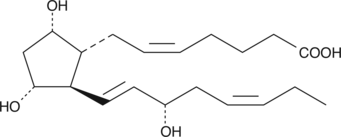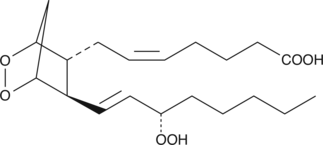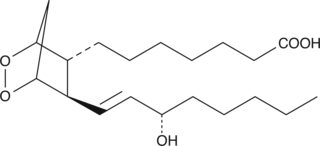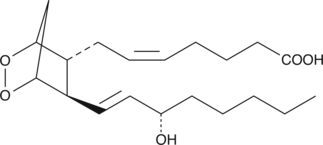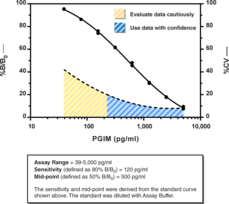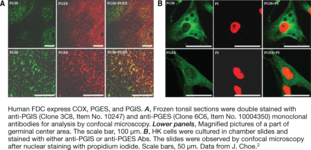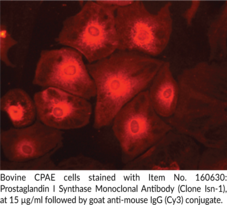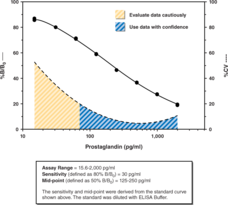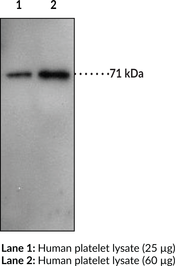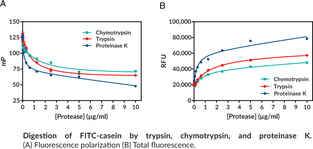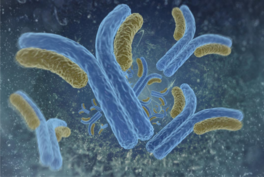Cayman
Showing 36451–36600 of 45550 results
-
Prostaglandin F2α-d4 (PGF2α-d4) contains four deuterium atoms at the 3, 3′, 4, and 4′ positions. It is intended for use as an internal standard for the quantification of PGF2α (Item No. 16010) by GC- or LC-mass spectrometry. PGF2α is a widely distributed prostaglandin occurring in many species.{187,421,796} It causes contraction of vascular, bronchial, intestinal, and myometrial smooth muscle, and also exerts potent luteolytic activity.{187} PGF2α exhibits its receptor mediated physiological activity at 50-100 nM.{187} Maximal ovine myometrial contraction can be achieved at 125 nM PGF2α in vitro.{1651}
Brand:CaymanSKU:316010 - 50 µgAvailable on backorder
Prostaglandin F2α-d4 (PGF2α-d4) contains four deuterium atoms at the 3, 3′, 4, and 4′ positions. It is intended for use as an internal standard for the quantification of PGF2α (Item No. 16010) by GC- or LC-mass spectrometry. PGF2α is a widely distributed prostaglandin occurring in many species.{187,421,796} It causes contraction of vascular, bronchial, intestinal, and myometrial smooth muscle, and also exerts potent luteolytic activity.{187} PGF2α exhibits its receptor mediated physiological activity at 50-100 nM.{187} Maximal ovine myometrial contraction can be achieved at 125 nM PGF2α in vitro.{1651}
Brand:CaymanSKU:316010 - 500 µgAvailable on backorder
Prostaglandin F2α-d4 (PGF2α-d4) is intended for use as an internal standard for the quantification of PGF2α (Item No. 16010) by GC- or LC-MS. PGF2α is a widely distributed prostaglandin occurring in many species.{187,421,796} It causes contraction of vascular, bronchial, intestinal, and myometrial smooth muscle, and also exerts potent luteolytic activity.{187} PGF2α exhibits its receptor mediated physiological activity at 50-100 nM.{187} Maximal ovine myometrial contraction can be achieved at 125 nM PGF2α in vitro.{1651} PGF2α-d4 MaxSpec® standard is a quantitative grade standard of PGF2α-d4(Item No. 316010) that has been prepared specifically for mass spectrometry and related applications where quantitative reproducibility is required. The solution has been prepared gravimetrically and is supplied in a deactivated glass ampule sealed under argon. The concentration was verified by comparison to an independently prepared calibration standard. This PGF2α-d4 MaxSpec® standard is guaranteed to meet identity, purity, stability, and concentration specifications and is provided with a batch-specific certificate of analysis. Ongoing stability testing is performed to ensure the concentration remains accurate throughout the shelf life of the product. Note: The amount of solution added to the vial is in excess of the listed amount. Therefore, it is necessary to accurately measure volumes for preparation of calibration standards. Follow recommended storage and handling conditions to maintain product quality.
Brand:CaymanSKU:10007275 - 10 µgAvailable on backorder
Prostaglandin F2β (PGF2β) is the 9β-hydroxy stereoisomer of PGF2α. It is much less active than PGF2α in antifertility and bronchoconstrictor activities.{1925,2121,633} PGF2β exhibits bronchodilating activity in guinea pigs and cats and antagonizes the bronchoconstrictor activity of PGF2α.{633}
Brand:CaymanSKU:-Out of stock
Prostaglandin F2β (PGF2β) is the 9β-hydroxy stereoisomer of PGF2α. It is much less active than PGF2α in antifertility and bronchoconstrictor activities.{1925,2121,633} PGF2β exhibits bronchodilating activity in guinea pigs and cats and antagonizes the bronchoconstrictor activity of PGF2α.{633}
Brand:CaymanSKU:-Out of stock
Prostaglandin F2β (PGF2β) is the 9β-hydroxy stereoisomer of PGF2α. It is much less active than PGF2α in antifertility and bronchoconstrictor activities.{1925,2121,633} PGF2β exhibits bronchodilating activity in guinea pigs and cats and antagonizes the bronchoconstrictor activity of PGF2α.{633}
Brand:CaymanSKU:-Out of stock
Prostaglandin F2β (PGF2β) (tromethamine salt) is a derivative of PGF2β (Item No. 16410) with increased water solubility. PGF2β is the 9β-hydroxy stereoisomer of PGF2α (Item No. 16010). It is much less active than PGF2α in antifertility and bronchoconstrictor activities.{1925,2121,633} PGF2β exhibits bronchodilating activity in guinea pigs and cats and antagonizes the bronchoconstrictor activity of PGF2α.{633}
Brand:CaymanSKU:-Out of stock
Prostaglandin F2β (PGF2β) (tromethamine salt) is a derivative of PGF2β (Item No. 16410) with increased water solubility. PGF2β is the 9β-hydroxy stereoisomer of PGF2α (Item No. 16010). It is much less active than PGF2α in antifertility and bronchoconstrictor activities.{1925,2121,633} PGF2β exhibits bronchodilating activity in guinea pigs and cats and antagonizes the bronchoconstrictor activity of PGF2α.{633}
Brand:CaymanSKU:-Out of stock
Prostaglandin F2β (PGF2β) (tromethamine salt) is a derivative of PGF2β (Item No. 16410) with increased water solubility. PGF2β is the 9β-hydroxy stereoisomer of PGF2α (Item No. 16010). It is much less active than PGF2α in antifertility and bronchoconstrictor activities.{1925,2121,633} PGF2β exhibits bronchodilating activity in guinea pigs and cats and antagonizes the bronchoconstrictor activity of PGF2α.{633}
Brand:CaymanSKU:-Out of stock
Prostaglandin F2β (PGF2β) is the 9β-hydroxy stereoisomer of PGF2α (Item Nos. 16010 | 10007221). It is much less active than PGF2α in antifertility and bronchoconstrictor activities.{1925,2121,633} PGF2β exhibits bronchodilating activity in guinea pigs and cats and antagonizes the bronchoconstrictor activity of PGF2α.{633} PGF2β MaxSpec® standard is a quantitative grade standard of PGF2β (Item No. 16410) that has been prepared specifically for mass spectrometry or any application where quantitative reproducibility is required. The solution has been prepared gravimetrically and is supplied in a deactivated glass ampule sealed under argon. The concentration was verified by comparison to an independently prepared calibration standard. This PGF2β MaxSpec® standard is guaranteed to meet identity, purity, stability, and concentration specifications and is provided with a batch-specific certificate of analysis. Ongoing stability testing is performed to ensure the concentration remains accurate throughout the shelf life of the product. Note: The amount of solution added to the vial is in excess of the listed amount. Therefore, it is necessary to accurately measure volumes for preparation of calibration standards. Follow recommended storage and handling conditions to maintain product quality.
Brand:CaymanSKU:10007232 - 100 µgAvailable on backorder
PGF3α is a COX product of EPA. The biosynthesis of PGF3α from EPA was demonstrated in vitro in human and rabbit ocular tissues.{1145} It has only 25% affinity at the ovine luteal FP receptor compared to PGF2α.{2058}
Brand:CaymanSKU:-Out of stock
PGF3α is a COX product of EPA. The biosynthesis of PGF3α from EPA was demonstrated in vitro in human and rabbit ocular tissues.{1145} It has only 25% affinity at the ovine luteal FP receptor compared to PGF2α.{2058}
Brand:CaymanSKU:-Out of stock
PGF3α is a COX product of EPA. The biosynthesis of PGF3α from EPA was demonstrated in vitro in human and rabbit ocular tissues.{1145} It has only 25% affinity at the ovine luteal FP receptor compared to PGF2α.{2058}
Brand:CaymanSKU:-Out of stock
PGF3α is a COX product of EPA. The biosynthesis of PGF3α from EPA was demonstrated in vitro in human and rabbit ocular tissues.{1145} It has only 25% affinity at the ovine luteal FP receptor compared to PGF2α.{2058}
Brand:CaymanSKU:-Out of stock
Prostaglandin G2 (PGG2) is the first intermediate in the COX pathway which is stable enough to be isolated and characterized.{499} It is the C-15 hydroperoxide of PGH2. Under normal conditions, PGG2 is quickly metabolized by the peroxidase activity intrinsic to both COX-1 and -2 to give PGH2, which serves as the key precursor to the 2-series PGs and thromboxanes.{499,759}
Brand:CaymanSKU:-Out of stock
Prostaglandin G2 (PGG2) is the first intermediate in the COX pathway which is stable enough to be isolated and characterized.{499} It is the C-15 hydroperoxide of PGH2. Under normal conditions, PGG2 is quickly metabolized by the peroxidase activity intrinsic to both COX-1 and -2 to give PGH2, which serves as the key precursor to the 2-series PGs and thromboxanes.{499,759}
Brand:CaymanSKU:-Out of stock
Prostaglandin G2 (PGG2) is the first intermediate in the COX pathway which is stable enough to be isolated and characterized.{499} It is the C-15 hydroperoxide of PGH2. Under normal conditions, PGG2 is quickly metabolized by the peroxidase activity intrinsic to both COX-1 and -2 to give PGH2, which serves as the key precursor to the 2-series PGs and thromboxanes.{499,759}
Brand:CaymanSKU:-Out of stock
Prostaglandin G2 (PGG2) is the first intermediate in the COX pathway which is stable enough to be isolated and characterized.{499} It is the C-15 hydroperoxide of PGH2. Under normal conditions, PGG2 is quickly metabolized by the peroxidase activity intrinsic to both COX-1 and -2 to give PGH2, which serves as the key precursor to the 2-series PGs and thromboxanes.{499,759}
Brand:CaymanSKU:-Out of stock
Prostaglandin H1 (PGH1) is a COX metabolite of DGLA and is the precursor to all 1-series PGs and thromboxanes. PGH1 is a suicide inhibitor of platelet thromboxane synthase with a Ki of 28 µM.{49}
Brand:CaymanSKU:-Out of stock
Prostaglandin H1 (PGH1) is a COX metabolite of DGLA and is the precursor to all 1-series PGs and thromboxanes. PGH1 is a suicide inhibitor of platelet thromboxane synthase with a Ki of 28 µM.{49}
Brand:CaymanSKU:-Out of stock
Prostaglandin H1 (PGH1) is a COX metabolite of DGLA and is the precursor to all 1-series PGs and thromboxanes. PGH1 is a suicide inhibitor of platelet thromboxane synthase with a Ki of 28 µM.{49}
Brand:CaymanSKU:-Out of stock
Prostaglandin H1 (PGH1) is a COX metabolite of DGLA and is the precursor to all 1-series PGs and thromboxanes. PGH1 is a suicide inhibitor of platelet thromboxane synthase with a Ki of 28 µM.{49}
Brand:CaymanSKU:-Out of stock
Prostaglandin H2 (PGH2) was first isolated from incubations of arachidonic acid with ovine seminal vesicle microsomes, and was described as a potent vasoconstrictor.{365} PGH2 is the precursor for all 2-series PGs and thromboxanes (TXs),{187} and is a TP receptor agonist which irreversibly aggregates human platelets at 50-100 ng/ml.
Brand:CaymanSKU:-Out of stock
Prostaglandin H2 (PGH2) was first isolated from incubations of arachidonic acid with ovine seminal vesicle microsomes, and was described as a potent vasoconstrictor.{365} PGH2 is the precursor for all 2-series PGs and thromboxanes (TXs),{187} and is a TP receptor agonist which irreversibly aggregates human platelets at 50-100 ng/ml.
Brand:CaymanSKU:-Out of stock
Prostaglandin H2 (PGH2) was first isolated from incubations of arachidonic acid with ovine seminal vesicle microsomes, and was described as a potent vasoconstrictor.{365} PGH2 is the precursor for all 2-series PGs and thromboxanes (TXs),{187} and is a TP receptor agonist which irreversibly aggregates human platelets at 50-100 ng/ml.
Brand:CaymanSKU:-Out of stock
Prostaglandin H2 (PGH2) was first isolated from incubations of arachidonic acid with ovine seminal vesicle microsomes, and was described as a potent vasoconstrictor.{365} PGH2 is the precursor for all 2-series PGs and thromboxanes (TXs),{187} and is a TP receptor agonist which irreversibly aggregates human platelets at 50-100 ng/ml.
Brand:CaymanSKU:-Out of stock
Brand:CaymanSKU:401103 - 10 mlAvailable on backorder
Prostaglandin I (Prostaglandin I2; PGI2) is a potent vasodilator and inhibitor of platelet aggregation that is formed from arachidonic acid primarily in the vascular endothelium and renal cortex by sequential activities of cyclooxygenase (COX) and PGI2 synthase. It is non-enzymatically hydrated to 6-keto PGF1α (t1/2 = 2-3 minutes), and then quickly converted to numerous downstream metabolites, collectively known as prostaglandin I metabolites or PGIM, (t1/2 = 30 minutes). Although 6-keto PGF1α is commonly measured in plasma and urine as an estimate of PGI2 synthesis, it should be noted that there may be more than one source of PGI2 in these samples. For instance, urinary concentrations of 6-keto PGF1α are confounded by the fact that only a portion originates from plasma and the remainder is produced by the kidney. These problems are circumvented by measuring downstream PGIM rather than 6-keto PGF1α as an indicator of systemic PGI2 production. Cayman’s PGIM ELISA Kit is a competitive assay that can be used for quantification of PGIM in urine and other sample matrices. The assay has a range from 39-5,000 pg/ml and a sensitivity (80% B/B0) of approximately 120 pg/ml.
Brand:CaymanSKU:501100 - 480 solid wellsAvailable on backorder
Prostaglandin I (Prostaglandin I2; PGI2) is a potent vasodilator and inhibitor of platelet aggregation that is formed from arachidonic acid primarily in the vascular endothelium and renal cortex by sequential activities of cyclooxygenase (COX) and PGI2 synthase. It is non-enzymatically hydrated to 6-keto PGF1α (t1/2 = 2-3 minutes), and then quickly converted to numerous downstream metabolites, collectively known as prostaglandin I metabolites or PGIM, (t1/2 = 30 minutes). Although 6-keto PGF1α is commonly measured in plasma and urine as an estimate of PGI2 synthesis, it should be noted that there may be more than one source of PGI2 in these samples. For instance, urinary concentrations of 6-keto PGF1α are confounded by the fact that only a portion originates from plasma and the remainder is produced by the kidney. These problems are circumvented by measuring downstream PGIM rather than 6-keto PGF1α as an indicator of systemic PGI2 production. Cayman’s PGIM ELISA Kit is a competitive assay that can be used for quantification of PGIM in urine and other sample matrices. The assay has a range from 39-5,000 pg/ml and a sensitivity (80% B/B0) of approximately 120 pg/ml.
Brand:CaymanSKU:501100 - 480 strip wellsAvailable on backorder
Prostaglandin I (Prostaglandin I2; PGI2) is a potent vasodilator and inhibitor of platelet aggregation that is formed from arachidonic acid primarily in the vascular endothelium and renal cortex by sequential activities of cyclooxygenase (COX) and PGI2 synthase. It is non-enzymatically hydrated to 6-keto PGF1α (t1/2 = 2-3 minutes), and then quickly converted to numerous downstream metabolites, collectively known as prostaglandin I metabolites or PGIM, (t1/2 = 30 minutes). Although 6-keto PGF1α is commonly measured in plasma and urine as an estimate of PGI2 synthesis, it should be noted that there may be more than one source of PGI2 in these samples. For instance, urinary concentrations of 6-keto PGF1α are confounded by the fact that only a portion originates from plasma and the remainder is produced by the kidney. These problems are circumvented by measuring downstream PGIM rather than 6-keto PGF1α as an indicator of systemic PGI2 production. Cayman’s PGIM ELISA Kit is a competitive assay that can be used for quantification of PGIM in urine and other sample matrices. The assay has a range from 39-5,000 pg/ml and a sensitivity (80% B/B0) of approximately 120 pg/ml.
Brand:CaymanSKU:501100 - 96 solid wellsAvailable on backorder
Prostaglandin I (Prostaglandin I2; PGI2) is a potent vasodilator and inhibitor of platelet aggregation that is formed from arachidonic acid primarily in the vascular endothelium and renal cortex by sequential activities of cyclooxygenase (COX) and PGI2 synthase. It is non-enzymatically hydrated to 6-keto PGF1α (t1/2 = 2-3 minutes), and then quickly converted to numerous downstream metabolites, collectively known as prostaglandin I metabolites or PGIM, (t1/2 = 30 minutes). Although 6-keto PGF1α is commonly measured in plasma and urine as an estimate of PGI2 synthesis, it should be noted that there may be more than one source of PGI2 in these samples. For instance, urinary concentrations of 6-keto PGF1α are confounded by the fact that only a portion originates from plasma and the remainder is produced by the kidney. These problems are circumvented by measuring downstream PGIM rather than 6-keto PGF1α as an indicator of systemic PGI2 production. Cayman’s PGIM ELISA Kit is a competitive assay that can be used for quantification of PGIM in urine and other sample matrices. The assay has a range from 39-5,000 pg/ml and a sensitivity (80% B/B0) of approximately 120 pg/ml.
Brand:CaymanSKU:501100 - 96 strip wellsAvailable on backorder
Brand:CaymanSKU:401104 - 50 ngAvailable on backorder
Immunogen: Synthetic peptide from the C-terminal region of mouse protein PGIS • Host: Rabbit • Species Reactivity: (+) Mouse, rat, bovine, and ovine • Applications: IHC and WB
Brand:CaymanSKU:100023- 1 eaAvailable on backorder
Immunogen: Synthetic peptide from the C-terminal region of mouse protein PGIS • Host: Rabbit • Species Reactivity: (+) Mouse, rat, bovine, and ovine • Applications: IHC and WB
Brand:CaymanSKU:100023- 1 eaPGIS catalyzes the isomerization of PGH2 to PGI2. PGI2 (prostacyclin) is a potent vasodilator and inhibitor of platelet aggregation. PGIS is a membrane-bound hemoprotein localized primarily in endothelial cells.{3475} The cloned bovine and human enzymes contain 500 amino acids and a calculated molecular mass of 56,629 and 57,103, respectively.{3476,3477,3478} Northern blot analysis reveals that the mRNA for PGIS is expressed in a wide variety of human tissues and is particularly abundant in ovary, heart, skeletal muscle, lung, and prostate.{3476}
Brand:CaymanSKU:100023 - 1 eaAvailable on backorder
Immunogen: Cell surface PGIS from follicular dendritic cell line HK • Host: Mouse • Species Reactivity: (+) Human, mouse, and rat PGIS • Application(s): WB, FC, ICC, IHC, and IP
Brand:CaymanSKU:10247- 1 eaProstaglandin I synthase (PGIS) catalyzes the isomerization of PGH2 to PGI2. PGI2 (prostacyclin) is a potent vasodilator and inhibitor of platelet aggregation. PGIS is a membrane-bound hemoprotein localized primarily in endothelial cells.{3476} The cloned bovine and human enzymes contain 500 amino acids and a calculated molecular mass of 56,629 and 57,103, respectively.{3477,3478,3475} Northern blot analysis reveals that the mRNA for PGIS is expressed in a wide variety of human tissues and is particularly abundant in ovary, heart, skeletal muscle, lung, and prostate.{3477}
Brand:CaymanSKU:10247 - 1 eaAvailable on backorder
Immunogen: Cell surface PGIS from follicular dendritic cell line HK • Host: Mouse • Species Reactivity: (+) Human, mouse, and rat PGIS • Application(s): WB, FC, ICC, IHC, and IP
Brand:CaymanSKU:10247- 1 eaAvailable on backorder
Immunogen: bovine lung PGIS • Host: mouse, clone isn-1 • Species Reactivity: (+) bovine, mouse, rat, ovine, guinea pig, and rabbit PGIS • Isotype: IgG1 • Application(s): IHC and IP; WB not recommended • PGIS catalyzes the conversion of PGH2 to PGI2 (prostacyclin).
Brand:CaymanSKU:160630- 1 eaPGI synthase (PGIS) catalyzes the conversion of PGH2 to PGI2 (prostacyclin). Human lung PGIS is a 56 kDa protein. The cloned bovine and human enzymes contain 500 amino acids and have a calculated molecular mass of 56,629 and 57,103, respectively.{3476,3477,3478} There is 88% homology between human and bovine PGIS.
Brand:CaymanSKU:160630 - 1 eaAvailable on backorder
Immunogen: bovine lung PGIS • Host: mouse, clone isn-1 • Species Reactivity: (+) bovine, mouse, rat, ovine, guinea pig, and rabbit PGIS • Isotype: IgG1 • Application(s): IHC and IP; WB not recommended • PGIS catalyzes the conversion of PGH2 to PGI2 (prostacyclin).
Brand:CaymanSKU:160630- 1 eaAvailable on backorder
Immunogen: Peptide from an internal region of bovine PGIS • Host: Rabbit • Species Reactivity: (+) Bovine, ovine, and human PGIS; (-) Rat PGIS • Application: WB • PGIS catalyzes the isomerization of PGH2 to PGI2, a potent vasodilator and inhibitor platelet aggregation
Brand:CaymanSKU:160640- 1 eaProstaglandin I synthase (PGIS) catalyzes the isomerization of PGH2 to PGI2. PGI2 (prostacyclin) is a potent vasodilator and inhibitor of platelet aggregation. PGIS is a membrane-bound hemoprotein localized primarily in endothelial cells.{3475} The cloned bovine and human enzymes contain 500 amino acids and a calculated molecular mass of 56,629 and 57,103, respectively.{3476,3477,3478} Northern blot analysis reveals that the mRNA for PGIS is expressed in a wide variety of human tissues and is particularly abundant in ovary, heart, skeletal muscle, lung, and prostate.{3476}
Brand:CaymanSKU:160640 - 1 eaAvailable on backorder
Immunogen: Peptide from an internal region of bovine PGIS • Host: Rabbit • Species Reactivity: (+) Bovine, ovine, and human PGIS; (-) Rat PGIS • Application: WB • PGIS catalyzes the isomerization of PGH2 to PGI2, a potent vasodilator and inhibitor platelet aggregation
Brand:CaymanSKU:160640- 1 eaAvailable on backorder
Prostaglandin I2 (PGI2) is an unstable cyclooxygenase metabolite detected first in vascular endothelial cells.{502,443,933} It elevates platelet cAMP and is a potent vasodilator and inhibitor of human platelet aggregation with an IC50 of 5 nM.{4375} PGI2 is stable in basic buffers (pH=8), but it is rapidly hydrolyzed to 6-keto PGF1α in neutral or acidic solutions. The half-life is short both in vivo and in vitro, ranging from 30 seconds to a few minutes. PGI2 is administered by continuous infusion in humans for the treatment of idiopathic pulmonary hypertension.{5466}
Brand:CaymanSKU:-Available on backorder
Prostaglandin I2 (PGI2) is an unstable cyclooxygenase metabolite detected first in vascular endothelial cells.{502,443,933} It elevates platelet cAMP and is a potent vasodilator and inhibitor of human platelet aggregation with an IC50 of 5 nM.{4375} PGI2 is stable in basic buffers (pH=8), but it is rapidly hydrolyzed to 6-keto PGF1α in neutral or acidic solutions. The half-life is short both in vivo and in vitro, ranging from 30 seconds to a few minutes. PGI2 is administered by continuous infusion in humans for the treatment of idiopathic pulmonary hypertension.{5466}
Brand:CaymanSKU:-Available on backorder
Prostaglandin I2 (PGI2) is an unstable cyclooxygenase metabolite detected first in vascular endothelial cells.{502,443,933} It elevates platelet cAMP and is a potent vasodilator and inhibitor of human platelet aggregation with an IC50 of 5 nM.{4375} PGI2 is stable in basic buffers (pH=8), but it is rapidly hydrolyzed to 6-keto PGF1α in neutral or acidic solutions. The half-life is short both in vivo and in vitro, ranging from 30 seconds to a few minutes. PGI2 is administered by continuous infusion in humans for the treatment of idiopathic pulmonary hypertension.{5466}
Brand:CaymanSKU:-Available on backorder
Prostaglandin I2 (PGI2) is an unstable cyclooxygenase metabolite detected first in vascular endothelial cells.{502,443,933} It elevates platelet cAMP and is a potent vasodilator and inhibitor of human platelet aggregation with an IC50 of 5 nM.{4375} PGI2 is stable in basic buffers (pH=8), but it is rapidly hydrolyzed to 6-keto PGF1α in neutral or acidic solutions. The half-life is short both in vivo and in vitro, ranging from 30 seconds to a few minutes. PGI2 is administered by continuous infusion in humans for the treatment of idiopathic pulmonary hypertension.{5466}
Brand:CaymanSKU:-Available on backorder
PGI3 is synthesized from EPA by COX and PGI synthase. PGI3 has a short in vivo half-life and is hydrolyzed to Δ17-6-keto PGF1α. The platelet and vascular activity of PGI3 is equivalent to that of PGI2.{1529,697}
Brand:CaymanSKU:-Available on backorder
PGI3 is synthesized from EPA by COX and PGI synthase. PGI3 has a short in vivo half-life and is hydrolyzed to Δ17-6-keto PGF1α. The platelet and vascular activity of PGI3 is equivalent to that of PGI2.{1529,697}
Brand:CaymanSKU:-Available on backorder
PGI3 is synthesized from EPA by COX and PGI synthase. PGI3 has a short in vivo half-life and is hydrolyzed to Δ17-6-keto PGF1α. The platelet and vascular activity of PGI3 is equivalent to that of PGI2.{1529,697}
Brand:CaymanSKU:-Available on backorder
PGI3 is synthesized from EPA by COX and PGI synthase. PGI3 has a short in vivo half-life and is hydrolyzed to Δ17-6-keto PGF1α. The platelet and vascular activity of PGI3 is equivalent to that of PGI2.{1529,697}
Brand:CaymanSKU:-Available on backorder
Prostaglandin J2 (PGJ2) is formed from PGD2 by the elimination of the C-9 hydroxyl group, a process which is accelerated by the presence of albumin.{1742} PGJ2 inhibits platelet aggregation with an IC50 of about 5-10 nM.{1139,504} PGJ2 has antimitotic and antiproliferative effects on a variety of cultured normal cells and tumor cell lines.{870} However, this activity has been attributed to further metabolites of PGJ2 and not the parent compound itself.
Brand:CaymanSKU:-Available on backorder
Prostaglandin J2 (PGJ2) is formed from PGD2 by the elimination of the C-9 hydroxyl group, a process which is accelerated by the presence of albumin.{1742} PGJ2 inhibits platelet aggregation with an IC50 of about 5-10 nM.{1139,504} PGJ2 has antimitotic and antiproliferative effects on a variety of cultured normal cells and tumor cell lines.{870} However, this activity has been attributed to further metabolites of PGJ2 and not the parent compound itself.
Brand:CaymanSKU:-Available on backorder
Prostaglandin J2 (PGJ2) is formed from PGD2 by the elimination of the C-9 hydroxyl group, a process which is accelerated by the presence of albumin.{1742} PGJ2 inhibits platelet aggregation with an IC50 of about 5-10 nM.{1139,504} PGJ2 has antimitotic and antiproliferative effects on a variety of cultured normal cells and tumor cell lines.{870} However, this activity has been attributed to further metabolites of PGJ2 and not the parent compound itself.
Brand:CaymanSKU:-Available on backorder
Prostaglandin J2 (PGJ2) is formed from PGD2 by the elimination of the C-9 hydroxyl group, a process which is accelerated by the presence of albumin.{1742} PGJ2 inhibits platelet aggregation with an IC50 of about 5-10 nM.{1139,504} PGJ2 has antimitotic and antiproliferative effects on a variety of cultured normal cells and tumor cell lines.{870} However, this activity has been attributed to further metabolites of PGJ2 and not the parent compound itself.
Brand:CaymanSKU:-Available on backorder
PGK1 is the 9,11-diketone formed by the oxidation of PGE1 or PGD1. Whether this compound exists biologically is uncertain; it is known to be resistant to metabolism by 15-hydroxy PGDH in vitro.{1789} In an intact porcine model of balloon angioplasty restenosis, PGK1 was equivalent in activity and potency to PGE1.{6703}
Brand:CaymanSKU:-Available on backorder
PGK1 is the 9,11-diketone formed by the oxidation of PGE1 or PGD1. Whether this compound exists biologically is uncertain; it is known to be resistant to metabolism by 15-hydroxy PGDH in vitro.{1789} In an intact porcine model of balloon angioplasty restenosis, PGK1 was equivalent in activity and potency to PGE1.{6703}
Brand:CaymanSKU:-Available on backorder
PGK1 is the 9,11-diketone formed by the oxidation of PGE1 or PGD1. Whether this compound exists biologically is uncertain; it is known to be resistant to metabolism by 15-hydroxy PGDH in vitro.{1789} In an intact porcine model of balloon angioplasty restenosis, PGK1 was equivalent in activity and potency to PGE1.{6703}
Brand:CaymanSKU:-Available on backorder
PGK1 is the 9,11-diketone formed by the oxidation of PGE1 or PGD1. Whether this compound exists biologically is uncertain; it is known to be resistant to metabolism by 15-hydroxy PGDH in vitro.{1789} In an intact porcine model of balloon angioplasty restenosis, PGK1 was equivalent in activity and potency to PGE1.{6703}
Brand:CaymanSKU:-Available on backorder
Prostaglandin K2 (PGK2) is the 9,11-diketone formed by the oxidation of PGE2 or PGD2. Whether this compound exists biologically is uncertain; it is known to be resistant to metabolism by 15-hydroxy PGDH in vitro.{1789}
Brand:CaymanSKU:-Available on backorder
Prostaglandin K2 (PGK2) is the 9,11-diketone formed by the oxidation of PGE2 or PGD2. Whether this compound exists biologically is uncertain; it is known to be resistant to metabolism by 15-hydroxy PGDH in vitro.{1789}
Brand:CaymanSKU:-Available on backorder
Prostaglandin K2 (PGK2) is the 9,11-diketone formed by the oxidation of PGE2 or PGD2. Whether this compound exists biologically is uncertain; it is known to be resistant to metabolism by 15-hydroxy PGDH in vitro.{1789}
Brand:CaymanSKU:-Available on backorder
Prostaglandin K2 (PGK2) is the 9,11-diketone formed by the oxidation of PGE2 or PGD2. Whether this compound exists biologically is uncertain; it is known to be resistant to metabolism by 15-hydroxy PGDH in vitro.{1789}
Brand:CaymanSKU:-Available on backorder
Brand:CaymanSKU:414016 - 100 dtnAvailable on backorder
Brand:CaymanSKU:414016 - 500 dtnAvailable on backorder
This assay was developed for screening applications in which the relative amount of prostaglandin (PG) production for a large number of cell culture samples must be determined. Our PGE2 assay (Item No. 514010) is unparalleled in sensitivity and specificity, but the steep standard curve can make screening many samples tedious. The specificity of the PGE2 assay also eliminates quantification of other PGs which may be produced by the cells. The antiserum used in this assay exhibits high cross reactivity for most PGs which will allow quantification of all the PGs in a given sample with a single assay. The broad standard curve minimizes the need for sample dilution. Because this assay will also recognize thromboxane B2 (TXB2), cell culture media must not contain fetal calf serum (FCS). The high concentration of TXB2 in serum (approximately 400 ng/ml) will completely displace the tracer, making PG measurement impossible.
Brand:CaymanSKU:514012 - 480 solid wellsAvailable on backorder
This assay was developed for screening applications in which the relative amount of prostaglandin (PG) production for a large number of cell culture samples must be determined. Our PGE2 assay (Item No. 514010) is unparalleled in sensitivity and specificity, but the steep standard curve can make screening many samples tedious. The specificity of the PGE2 assay also eliminates quantification of other PGs which may be produced by the cells. The antiserum used in this assay exhibits high cross reactivity for most PGs which will allow quantification of all the PGs in a given sample with a single assay. The broad standard curve minimizes the need for sample dilution. Because this assay will also recognize thromboxane B2 (TXB2), cell culture media must not contain fetal calf serum (FCS). The high concentration of TXB2 in serum (approximately 400 ng/ml) will completely displace the tracer, making PG measurement impossible.
Brand:CaymanSKU:514012 - 480 strip wellsAvailable on backorder
This assay was developed for screening applications in which the relative amount of prostaglandin (PG) production for a large number of cell culture samples must be determined. Our PGE2 assay (Item No. 514010) is unparalleled in sensitivity and specificity, but the steep standard curve can make screening many samples tedious. The specificity of the PGE2 assay also eliminates quantification of other PGs which may be produced by the cells. The antiserum used in this assay exhibits high cross reactivity for most PGs which will allow quantification of all the PGs in a given sample with a single assay. The broad standard curve minimizes the need for sample dilution. Because this assay will also recognize thromboxane B2 (TXB2), cell culture media must not contain fetal calf serum (FCS). The high concentration of TXB2 in serum (approximately 400 ng/ml) will completely displace the tracer, making PG measurement impossible.
Brand:CaymanSKU:514012 - 96 solid wellsAvailable on backorder
This assay was developed for screening applications in which the relative amount of prostaglandin (PG) production for a large number of cell culture samples must be determined. Our PGE2 assay (Item No. 514010) is unparalleled in sensitivity and specificity, but the steep standard curve can make screening many samples tedious. The specificity of the PGE2 assay also eliminates quantification of other PGs which may be produced by the cells. The antiserum used in this assay exhibits high cross reactivity for most PGs which will allow quantification of all the PGs in a given sample with a single assay. The broad standard curve minimizes the need for sample dilution. Because this assay will also recognize thromboxane B2 (TXB2), cell culture media must not contain fetal calf serum (FCS). The high concentration of TXB2 in serum (approximately 400 ng/ml) will completely displace the tracer, making PG measurement impossible.
Brand:CaymanSKU:514012 - 96 strip wellsAvailable on backorder
Brand:CaymanSKU:414026 - 1 eaAvailable on backorder
Antigen: human PGT C-terminal amino acids 627-640 • Host: rabbit • Cross Reactivity: (+) human, mouse, rat, cow, and sheep PGT; expected to react with canine and chicken PGT • Application(s): ICC, IF, and WB • Transport of extracellular prostaglandins into cells occurs via a specific PG transporter (PGT).
Brand:CaymanSKU:11860- 1 eaAvailable on backorder
Antigen: human PGT C-terminal amino acids 627-640 • Host: rabbit • Cross Reactivity: (+) human, mouse, rat, cow, and sheep PGT; expected to react with canine and chicken PGT • Application(s): ICC, IF, and WB • Transport of extracellular prostaglandins into cells occurs via a specific PG transporter (PGT).
Brand:CaymanSKU:11860- 1 eaProstaglandins (PGs) are signaling molecules that modulate physiological or pathologic functions such as platelet aggregation, vascular tone, gastric cytoprotection, uterine contraction, inflammation, cancer and Alzheimer’s disease.{310,1606,3947,9898,10008,11300} PG transporter (PGT) is generally expressed in endothelial and epithelial cells. Transport of extracellular PGs into cells occurs via a specific PGT, allowing PG oxidation by 15-hydroxy PG dehydrogenase or binding with their respective receptor(s).{1917,3471,21013} Cayman’s peptide-affinity purified PGT polyclonal antibody detects a 71 kDa band on WB. Loss of PGT detection may occur due to cell membrane aggregation during exposure of some samples to high temperature processing.{21648} Therefore treatment of the protein sample at 37°C for 15 minutes (water bath or heating block), and if desired, in parallel with another aliquot at 95°C is recommended prior to electrophoresis and blotting. When using the antibody for ICC or IF, cell permeabilization is necessary due to the intracellular location of the antibody binding site (C-terminal amino acids).
Brand:CaymanSKU:11860 - 1 eaAvailable on backorder
Activation of latent reservoirs of HIV-infected cells is a treatment strategy designed to reduce viral load and eliminate the perpetuation of retroviral infection. Prostratin is a non-tumor promoting phorbol ester that potently induces HIV-1 reactivation in latent reservoirs of infected Jurkat-LAT-GFP cells with an IC50 value of ~0.5 µM.{17117} Originally, prostratin was isolated from plant sources including P. prostrata, E. cornigera, and H. nutans. {15812} The effects of prostratin are mediated through activation of NF-κB via protein kinase C and by downregulation of HIV-1 receptor CD4 expression and its co-receptors CXCR4 and CCR5.{17116,17118,17119}
Brand:CaymanSKU:10272 - 1 mgAvailable on backorder
Activation of latent reservoirs of HIV-infected cells is a treatment strategy designed to reduce viral load and eliminate the perpetuation of retroviral infection. Prostratin is a non-tumor promoting phorbol ester that potently induces HIV-1 reactivation in latent reservoirs of infected Jurkat-LAT-GFP cells with an IC50 value of ~0.5 µM.{17117} Originally, prostratin was isolated from plant sources including P. prostrata, E. cornigera, and H. nutans. {15812} The effects of prostratin are mediated through activation of NF-κB via protein kinase C and by downregulation of HIV-1 receptor CD4 expression and its co-receptors CXCR4 and CCR5.{17116,17118,17119}
Brand:CaymanSKU:10272 - 10 mgAvailable on backorder
Activation of latent reservoirs of HIV-infected cells is a treatment strategy designed to reduce viral load and eliminate the perpetuation of retroviral infection. Prostratin is a non-tumor promoting phorbol ester that potently induces HIV-1 reactivation in latent reservoirs of infected Jurkat-LAT-GFP cells with an IC50 value of ~0.5 µM.{17117} Originally, prostratin was isolated from plant sources including P. prostrata, E. cornigera, and H. nutans. {15812} The effects of prostratin are mediated through activation of NF-κB via protein kinase C and by downregulation of HIV-1 receptor CD4 expression and its co-receptors CXCR4 and CCR5.{17116,17118,17119}
Brand:CaymanSKU:10272 - 5 mgAvailable on backorder
Activation of latent reservoirs of HIV-infected cells is a treatment strategy designed to reduce viral load and eliminate the perpetuation of retroviral infection. Prostratin is a non-tumor promoting phorbol ester that potently induces HIV-1 reactivation in latent reservoirs of infected Jurkat-LAT-GFP cells with an IC50 value of ~0.5 µM.{17117} Originally, prostratin was isolated from plant sources including P. prostrata, E. cornigera, and H. nutans. {15812} The effects of prostratin are mediated through activation of NF-κB via protein kinase C and by downregulation of HIV-1 receptor CD4 expression and its co-receptors CXCR4 and CCR5.{17116,17118,17119}
Brand:CaymanSKU:10272 - 500 µgAvailable on backorder
proTAME is a cell-permeable prodrug form of N-4-tosyl-L-arginine methyl ester (TAME; Item No. 17550), an inhibitor of the anaphase-promoting complex/cyclosome (APC/C), that is converted to TAME by intracellular esterases.{28533,36286} proTAME (12 μM) blocks association of APC/C with the activator CDH1 and inhibits degradation of APC/C substrates in HeLa cells.{28533} It induces mitotic arrest in metaphase followed by cell death in synchronized HeLa H2B-GFP cells when used at a concentration of 12 μM. It also increases mitotic duration in asynchronous HeLa H2B-GFP cells at a concentration of 4 μM, an effect that is enhanced by knockdown of the APC/C co-activator CDC20. proTAME decreases the viability of several laboratory and primary patient-derived human multiple myeloma (MM) cell lines (IC50s = 2.8-20.3 μM) and increases apoptosis in RPMI-8226, LP-1, NCI-H929, and U266 MM cells when used at a concentration of 12 μM.{36286}
Brand:CaymanSKU:25835 - 1 mgAvailable on backorder
Cayman’s Protease Activity Assay Kit provides a convenient method for determining the activity of proteases in samples. Proteolytic digestion of the FITC-casein substrate can be monitored by changes in either fluorescence polarization (FP) or total fluorescence.{33943} Fluorescence is the ability of a molecule to absorb the energy of an incoming (excitation) photon and then re-emit this energy as a new, slightly less energetic (emission) photon. A small fluorescent molecule will rotate appreciably during the very small interval of time between absorption of a photon and emission of the fluorescence photon. If the excitation light is polarized, this rotation will result in randomization of the plane of the emitted light. Thus, small fluorescent molecules depolarize an excitation pulse of polarized light. Large fluorescent molecules, like FITC-casein, do not rotate as appreciably in the same small interval of time. They will, therefore, emit light that retains some of the polarization of the polarized excitation light. This polarization is quantified as millipolarization units, or mP. In this assay, the total FP decreases as the FITC-casein is digested into smaller, quicker rotating fluorescein-labeled fragments. If measuring FP is not available, the change in total fluorescence can also be measured to determine protease activity. The conjugation of FITC to casein results in moderate quenching of the total fluorescence. This fluorescence increases as the FITC-casein substrate is digested into smaller fluorescein-labeled fragments. Both assay formats use an excitation wavelength of 480-495 nm and an emission wavelength of 515-525 nm.
Brand:CaymanSKU:701410 - 96 wellsAvailable on backorder
Brand:CaymanSKU:32979- 100 µl





